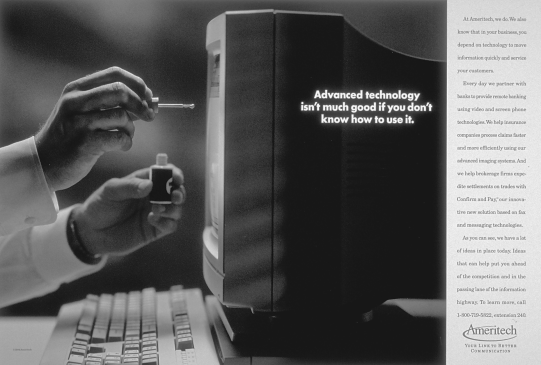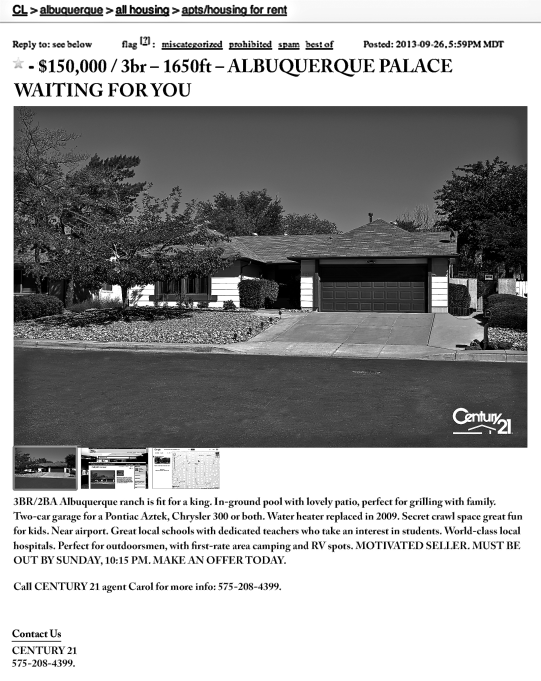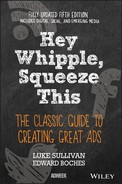
Figure 10.1 Yeah, it takes a while to adapt to new media.
10
Digital Isn't a Medium, It's a Way of Life
Ads, Media, Content, and Customers—They've All Gone Digital
For 50 years, print, radio, and television commercials were pretty much all that ad agencies created. Times were good. Not because everybody was constantly drunk like in Mad Men. They were good because as long as agencies could buy the media and control the message, they pretty much owned a prospective customer's attention.
Then, before you could say, “I'll have an Old Fashioned,” it all changed.
The emergence of the social Web and the arrival of YouTube, Facebook, Twitter, and smartphones threw a massive wrench into the world of advertising. All of a sudden people had the ability to filter or avoid advertising altogether. Overnight, they had new ways to control when, where, and how they accessed information. They could share videos and distribute links. They could create and publish their own content. And since the Internet is essentially infinite, media became abundant while attention grew scarce—the complete opposite of the world for which ad agencies were created.
These changes—social media, user-generated content, and the new digital devices that helped enable them—brought disruption to every creative industry, not just the ad industry. The music business, book publishers, newspapers, television, even video games all had to completely rethink their business models: what they made, how they made it, the forms it took, how it was distributed, and the role the user played in all of it. Many healthy companies went paws up—some overnight—because they didn't adapt quickly enough.
As an industry, advertising was particularly unprepared. In fact, most agencies were so slow to change that many observers, including Fast Company, predicted the industry's demise. Clay Shirky, one of the more prominent thinkers on the Internet, put it well: “We are living through the disorientation that comes from including two billion new participants in a media landscape previously operated by a small group of professionals.” Note that Clay didn't say “dying from.” He said “living through,” which was what actually happened. The industry had to change, learn new skills, and find new ways to connect with customers. It was painful and some people resisted, at least for a while. But advertising didn't disappear. Just those with their heads in the sand.
We Are So Not In Kansas Anymore
You can see evidence of this disruption everywhere. Traditional agencies strive to evolve from full-time message makers to companies that emphasize digital and social. They're rethinking models that sell employees' time and exploring ways to harness and work with creativity from outside their own walls. To demonstrate their digital chops, some shops are even building in-house innovation labs and incubating startups.
There's evidence in the proliferation of new agencies that specialize in user experience (UX), experiential advertising, and mobile. They claim that companies born and bred for a digital market will be better at creating more relevant ideas for the new platforms. It even says so on their shingles. Rather than setting the names of their founders in big letters (which places all the emphasis on a few individuals), the new digital agencies have names like Big Spaceship (big is inclusive, there's room for everyone on a big spaceship), Taxi (a small, dedicated team of experts that can fit in a cab), and Naked (because in the twenty-first century, brands can no longer hide behind an image).
One of our favorite names is Made by Many. While this London-based innovation accelerator isn't really an agency, its early work for brands like Burberry and Skype demonstrates the kind of creative that agencies will be emulating in the years ahead. These new company names emphasize collaboration and inclusion. They acknowledge an interconnectedness between brands and users. And they declare that all of us are better than one of us. Great qualities for the digital age.
The increased popularity of crowdsourcing is another example of the disruption in the ad industry. Companies like Victors & Spoils and Ideasicle have pioneered new agency models that draw talent from a worldwide creative pool and not just the agency creative department. Victors & Spoils, which sources ideas from its own creative department as well as from the crowd, has managed to win accounts like Harley-Davidson and Dish Network and do great work for them. And Ideasicle, which cobbles together virtual creative teams from a select network of talent, regularly snags assignments from big name brands.
It's not About Making “Digital Advertising.” It's About Making Advertising for a Digital World
A strategist at Fallon was overheard saying, “I am so over messages.” There are many in the business who share this sentiment and who question the whole format of paid messaging. It worked fine in the 1950s when TV was new and citizens were happy to listen to the boring man tell them Anacin worked “fast-fast-fast.”
The power of controlled messages has lost its impact. The manufacturers, publishers, broadcasters, and programmers now bow to customers, readers, and viewers. Advertising messages like TV spots and magazine ads were once an agency's main offering. But today, applications, utility, and tech platforms are becoming some of the most important creative output.
So what does it all mean? Should you be paranoid if you can't write a line of code or don't know the difference between front- and back-end development? Will the industry even need creatives a decade from now?
There are in fact some very smart ways for you to approach this stuff, as well as some basic strategies to help you think in a new way about advertising. Ideally they will save you from simply retrofitting practices learned in traditional media (something that still happens quite a lot).
As we get into it, we're not going to worry about becoming digital experts, because we never will. All we can do is dive in and start. Along the way we'll try to keep our head in what's often called a “permanent beta mentality”—constantly experimenting and trying different tactics. If something doesn't work, we'll try something else. (In fact, even if it does work, we'll try something else.)
So, take a breath. Today it's not so much about making digital advertising as it is about making advertising for a digital world. Sure, you could benefit from learning to write code, but as an advertising creative your focus needs to be on how people use the Web, mobile, and the new technologies. And as far as job security goes, algorithms will never replace the value of a good idea or a compelling story. In fact, the more content there is the more valuable good content becomes.
Funny, It Doesn't Look Like Advertising
Before we think about how to create advertising ideas for the digital world, let's take a look at a few campaigns that changed our definition of advertising in recent years. These campaigns don't look or feel much like the advertising discussed in Chapters 4 and 5. Some completely bypassed traditional media. Some don't have headlines. A few had production budgets of $0.00. One handed the entire campaign over to strangers with practically no supervision at all. And one didn't come from a client or an agency, but from one person who had a compelling idea.
Yet they all have something in common. They understand digital isn't simply a technology, or a platform, or a medium. Digital is a way of life. People live digitally. It's an entirely new behavior, a way in which people find, watch, share, and even produce the content we now call advertising. For advertising agencies, digital is a different way of connecting with users and of creating and distributing ideas and content across an ever-changing media landscape.
Up until now we've talked about the crafts of copywriting and art direction and how they apply to making ads. But these crafts can also help you create things someone might actually look forward to seeing. So as we move into the new world, we'll expand our definition of advertising to include anything that brings a brand to life for customers. This could take almost any form: a mobile app, a blog, a game, a movie or TV show, a retail experience, a book, a song, an online service, a new product; pretty much anything but advertising. The key difference is that your creation must be interesting in its own right and have a reason to exist beyond just a brand's message.
If you're thinking, “Damn, just when I learned how to write a decent headline, everything changes,” don't worry. All the classic advertising creative skills have a place in the new world. But first it's worth a look at a few examples that dramatize the difference between the old world and the new: advertising that relied on controlled messages and paid media vs. advertising that invites participation and earns attention. Check out these non-advertising advertising ideas. (They're all viewable at bit.ly/whipple5.)
Red Bull Gives Users a Rush Online
In 2012, the energy drink dropped Austrian daredevil Felix Baumgartner out of a helium balloon 24 miles above the Earth's surface, breaking the record for the highest altitude skydive ever. The video of Red Bull's Stratos mission (Figure 10.2) was so riveting 8 million people watched the drama stream in real time. As of this writing, the video has tallied up some 38 million views. Had this piece been entered in award shows as a “TV commercial,” it likely would've cleaned up, but Red Bull didn't run it as a paid commercial. They created a live-streamed media event that earned attention and news coverage with mind-blowing digital content. whipple5redbull

Figure 10.2 Red Bull sponsored an over-the-top event and then wisely stayed out of the way. Meaning, when he landed, Felix didn't hold up a can of Red Bull.
Dove Produces a Mini-Documentary
How do you sell beauty products in the digital age? Dove U.K. and Ogilvy Brazil hired an FBI-trained sketch artist to draw two sketches of seven different women. The first set of sketches was based on each woman's description of herself. The second was drawn from a description provided by a complete stranger who'd only just met the woman. Poignantly, the strangers' descriptions were both more flattering and lifelike than the woman's own description of herself. The mini-documentary dramatically conveyed the difference between the way women see themselves and how others see them. Dove's Campaign for Real Beauty didn't air on network or even cable TV, but on YouTube. “You are more beautiful than you think,” intoned the voice-over over Dove's logo and Web address, and the world beat a path to its doorstep with 65 million views. The brand didn't produce a traditional commercial or buy TV time; rather it orchestrated, documented, and shared a social experiment.
The Swedish Institute Gives Away Its Twitter Feed
In an attempt to attract trade, investment, and tourists, the country of Sweden's marketing arm handed its Twitter account over to a different Swedish citizen every week to tweet about their country and all Sweden had to offer. The idea was that the uncensored “curators” could convey a better, more honest, and more insightful view of Sweden than an ad agency ever could. In 2012, this simple idea, requiring virtually no creative from the client or the agency, generated buzz on Twitter, attracted attention from the press, and won multiple Lions at Cannes. The institute not only eschewed advertising, it relinquished control of the message, trusting the community to sell Sweden.
Century 21 Hijacks the Finale of Breaking Bad
While brands with bigger ad budgets were coughing up $400,000 for a 30-second commercial on the finale of AMC's Breaking Bad, a real-estate company and its agency Mullen took a more original approach. They listed the actual three-bedroom ranch house “owned by Walter White” on Craigslist—complete with references to scenes fans knew by heart, and a phone number that was actually staffed on the other end (Figure 10.3). The marketer then turned the social media team loose on Twitter and Facebook where they connected with followers, fans, bloggers, and the press. The result was well over 80 million impressions (and a gold Pencil from the One Show). All for a budget of diddly-squat; posting on Craigslist is free. Instead of buying an expensive commercial on the finale, Century 21 created an ad out of the finale, hijacking a popular and very visible media event. whipple5bad

Figure 10.3 On the Internet, digital thinking can turn a classified ad into a viral sensation.
Lowe's Starts Running Six-Second Commercials
Lowe's and BBDO created a charming series of six-second how-to videos posted on the social network Vine, cleverly titled “Fix in Six” (Figure 10.4). Tagged #lowesfixinsix, these videos regularly garnered over 200,000 views, thousands of likes, and hundreds of “revines.” The campaign got many of its fix-it tips from fans and users on Twitter and then handed them over to short-film animator and digital entrepreneur Meagan Cignoli, who added her interpretation and cinematic touch. Ultimately, Fix in Six was not so much an ad for the hardware giant as it was a service for Lowe's customers. whipple5fix6

Figure 10.4 The medium is the message. Even before you hit play, the six-second length says, “This should be easy.”
Ice Bucket Challenge Raises $100 Million. Media Investment: $0.00
It had no headline, no artwork, no video, and no website. It wasn't created by either an organization or an agency. Yet the Ice Bucket Challenge raised $100 million in a single month in the fight against amyotrophic lateral sclerosis, or Lou Gehrig's disease.1 Over 28 million people poured buckets of ice water over their heads and shared it in their Facebook newsfeed.2 All in all, it wasn't so much a fund-raiser as it was a crowdsourced social media campaign.
Advertising in the digital world is different from advertising in an analog one. Digital ideas can live anywhere online. They can be an experience rather than a message, while users of social media can play the roles of both content creator and media channel.
Note also that while some of the ideas were designed with a specific medium in mind—#lowesfixinsix for Vine, Sweden's curators for Twitter, the Ice Bucket Challenge for Facebook—none of them were confined to any one medium. Faris Yakob, founder of Genius Steals, reminds us in his new book Paid Attention, “Content flows across what we previously thought of as channels, and different parts of the system can effect change in other parts.” So Lowe's Fix In Six starts on Vine and can end up on Tumblr. Tweets can be automatically fed to a website. And any video can migrate from YouTube to Facebook to Twitter. The digital environment frees ideas and content to live anywhere.
Perhaps even more exciting is that when everything is connected, we can combine even three or four different digital media and devices to create a single idea.
Digital Advertising can be Building Things Out of Connected Devices
Consider this last example, a campaign for the United Nations' effort to eliminate still-buried landmines. Typically, an ad agency given an assignment like this might produce a public-service TV spot and pray the networks air it at some time slot other than 3 AM. But in 2014, Critical Mass, which calls itself an experience design agency, did something different.
The agency created “Sweeper,” a multisensory exhibit on land mines at the New Museum in New York City. Sweeper simulated the hidden danger of landmines using physical space, Apple's iBeacon technology, a smartphone app, and sound effects.
Visitors to the exhibit, while viewing Marco Grob's moving portraits of mine victims, had to stroll through a virtual minefield with no idea where the “mines” might be buried. When they triggered a digital mine, they heard the explosion and learned of their gruesome injuries via the app on their iPhones (Figure 10.5). At the exhibit's end, Critical Mass helped convert the visitor experience into a fund raiser. The agency had arranged with AT&T and Verizon for the app to include a one-touch donation that could simply be added to a user's next phone bill.

Figure 10.5 LEFT: The woman is about to set off the virtual landmine concealed in the highlighted box. RIGHT: Her app tells her what kind of landmine just killed her. whipple5landmines
Sweeper could not have existed in any one medium. It needed physical space, digital technology, a smartphone app, art, and copy. It was a narrative concept but required systems thinking (more on that soon) to see the possibilities of what could be done.
Is this advertising? Damn straight it is. It builds awareness. Attracts attention. Generates action. Raises money. It just happens to be made out of code, sensors, apps, and a participatory experience rather than words and pictures.
So how do we make stuff like this? First order of business: We change our thinking.
